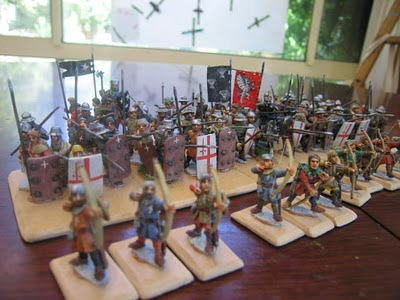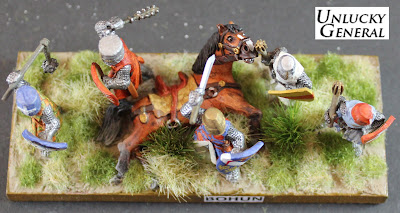Rebel Left Ward - London Foot (1): Modelling
The manufacturers represented in this unit include almost even proportions of Kingmaker Miniatures, Curtey's Miniatures, Essex Miniatures, Foundry, Gripping Beast and Mirliton Miniatures. I have swapped shields, spears, made other spears, cut away pre-moulded weapons and replaced them with spears and filed away some armoured joints which would not have appeared until later. I have given this unit a unit standard, a musician (horn) and squires for the commander (Nicholas de Segrave) and Thomas Pelveston, holding their banners. Thomas of Pelveston is a second leader, referred to in the texts, being who for wargaming purposes remains present purely for historical aesthetics and, though mounted, I will be positioning him further back amongst the ranks. More on Pelveston and de Segrave in a separate posting.
 Included in this unit are a dozen spearmen armed with pavise style shields and a goodly number of figures with long thrusting spears charged at the ready in both hands. More so than ever, this unit has required more thought in how to model it with what is essentially a shield wall to the front with supporting spears in up to the third rank set forward to meet the enemy. They are based on 70 x 60 mm bases (nine figures to a base) with the additional 10mm of depth to allow for the charged spears. I retained the ordinary spears with the Curteys' Miniatures and there are a smaller number of other weapons mixed in. Whilst some figures are unarmoured, the vast majority are mailed, scaled and in padded gambesons.
Included in this unit are a dozen spearmen armed with pavise style shields and a goodly number of figures with long thrusting spears charged at the ready in both hands. More so than ever, this unit has required more thought in how to model it with what is essentially a shield wall to the front with supporting spears in up to the third rank set forward to meet the enemy. They are based on 70 x 60 mm bases (nine figures to a base) with the additional 10mm of depth to allow for the charged spears. I retained the ordinary spears with the Curteys' Miniatures and there are a smaller number of other weapons mixed in. Whilst some figures are unarmoured, the vast majority are mailed, scaled and in padded gambesons.I have based the remainder two figures deep and three wide, arranged to represent the unit deployed in a frontage of 12 figures but clearly this is entirely adaptable. Only the archers are based singly to allow skirmishing and deployment to the rear of this mixed order unit. I am employing sheet metal strips to gather the single archers together when with the unit - all my bases being glued on magnetic sheet.
My approach to painting a unit of this size was to detail the faces and hair types first - an enormous task considering there are 162 individual eyes to paint alone. I took great care to stage my efforts to avoid monotony setting in, mentally dividing the unit into types. I then separated all the gambesoned troops and took care of their 'armour', then likewise the undercoat for the mailed troops (for me a thinned mixture of Humbrol Gunmetal and Gloss Black enamel) followed by variations on metal scale armour. I then randomised the selection into even groups by colour types, ensuring that identical models have different colours. I worked on the concept of 8x10, being eight groups of ten figures, each group having the same colour over shirt. At the same time, I would paint one figure from each of the other groups with the same colour for their hosen. At the end of this process I have 80 different colour combinations for this irregular unit. Then I apply a similar process to the few figures who remain with unpainted hoods and exposed under-shirts.
I separated the archers after the basic colouring process and brought them to a finish. For me, it's important to have something final to show for what has already taken many, many hours of labour. I then reversed my normal order of painting and painted all of my command group including flags. I then finished the dozen pavise figures by which time I felt up to tackling the remainder in one effort.
I determined to paint all of my heater shields for this unit with the traditional Saint George cross which has been associated with the arms of London for as long as anyone can remember. This is also to represent that element of the militia equipment supplied by the city. The pavise shields I have made in natural wood colours with the adoption of the Baron's white cross field or campaign sign in small. Four pavise shields have the full arms of London heraldic designs upon them, being the broader canvas. Generally, I wanted these city men to have a little more colour than their country cousins and have applied more hues of red and blue to give them a slightly richer and bolder field presence than the other units of foot I have made to date.
Normally this body of well armed men would make for a formidable opponent in the field of battle and the table-top wargame. Formidable, that is, unless you are a division of sixty heavily armed and armoured knights, sergeants and squires which is what they will face in the Lewes re-fight. I am inclined toward the theory that foot soldiery of this period in all probability still have drill reminiscent of shieldwall tactics of the later dark-age period favoured by the Saxons and vikings. There is not a lot I have found on infantry tactics of this period and certainly no rule mechanism exists to support my suspicions. In Warhammer Ancient Battles (WAB) doctrine the only loss of the Shieldwall application is a -1 penalty to missile and melee to the front but with a twelve figure frontage and depth of seven, in the WAB First Edition the morale and combat determination bonus of +3 for up to three ranks will remain in place until more than 40 figures are lost.








Comments
cheers
matt
Great looking army mate..Are you going to "landscape" the bases?
Cheers
Paul
cheers
Matt